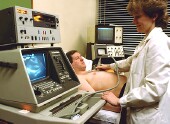
TUESDAY, June 1 (HealthDay News) — Americans hospitalized for heart failure are being discharged faster, but the incidence of out-of-hospital deaths and readmissions has increased, a new study finds.
While in-hospital death rates have decreased, “the results are very mixed, and overall you could say that they are worse off,” said Dr. Harlan M. Krumholz, professor of medicine at Yale University and a member of a team reporting the finding in the June 2 issue of the Journal of the American Medical Association.
In the study of nearly 7 million Medicare-financed hospitalizations for heart failure, the progressive loss of ability to pump blood, the researchers found that the average length of stay decreased by 2.5 days, from 8.8 days in 1993 to 6.3 days in 2006. The in-hospital death rate was nearly halved, dropping from 8.5 percent to 4.3 percent.
But the overall death rate for the 30-day period starting with hospital admission increased, from 4.3 percent in 1993 to 6.4 percent in 2006, meaning that more deaths occurred after discharge. The net reduction in deaths for the 30 days starting with hospital admission was smaller than for the in-hospital rate, from 12.8 percent in 1993 to 10.7 percent in 2006.
And 20.1 percent of those who left the hospital were readmitted in 2006, compared to 17.1 percent in 1993.
“Patients lost ground when they went home,” Krumholz said. “There was no incentive to look at what was happening after discharge. The hospitals kept the patients for the shortest period of time, sent them home and ended up hoping for the best.”
It’s not clear that there is a direct relationship between a shorter hospital stay and more post-hospital deaths and readmissions, said Dr. Adrian F. Hernandez, an assistant professor of medicine at Duke University, who recently led a study showing that hospitals that took pains to prepare heart failure patients for home care had better out-of-hospital results.
“This study highlights that readmission is a common and growing problem,” Hernandez said. “But the demographics of patients admitted with heart failure has changed over time. Patients now tend to be older and sicker.”
Discharges to nursing homes have increased, the new study found, from 13 percent of all discharges in 1996 to 19.9 percent in 2006.
Better hospital discharge practices are needed to improve the out-of-hospital results, Krumholz and Hernandez both said.
“Unless you strengthen the patients with stronger support when they go home, you may run the risk of worsening things,” Krumholz said. “You need to make sure people are ready to go home — make a doctor’s appointment, make sure they take the medications they are prescribed, have a plan of who they should call if they don’t feel well.”
“We should incentivize hospitals or health-care systems to take care of patients for the whole 30 days starting with hospital admission,” Hernandez said. His study found that careful instructions about what should and shouldn’t be done, with a follow-up check, reduced out-of-hospital problems, but it also found that most hospitals didn’t provide such measures.
“From our study, it appears that, on average, you have early follow-up in less than 40 percent of hospitals,” Hernandez said. “There is room for improvement.”
At Yale, “we are interviewing patients and focusing on the transition period,” Krumholz said. “There are new mechanisms that are very successful in navigating this very treacherous period.”
Another report in the same issue of the journal found that people with heart attacks who did not get artery-opening treatment in the 90-minute window recommended in clinical guidelines had a significantly higher risk of death within 30 days or major problems in the following year compared to those whose treatment met the guidelines.
Waiting times for treatment simply are often too long, said study leader Laurie Lambert, principal epidemiologist in the cardiology unit of the Quebec Healthcare Assessment Agency.
“Our study suggests you need to look at the processes of care,” Lambert said. “It is more important that patients be treated on time than which treatment they get.”
More information
To learn about heart failure and its management, visit the American Heart Association.

